East India Company
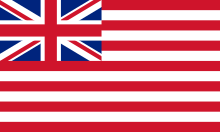 Company flag (1801) | |
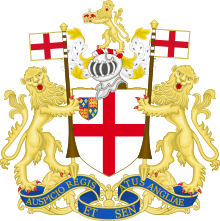 Coat of arms (1698) Motto: Auspicio Regis et Senatus Angliae Latin for "By command of the King and Parliament of England" | |
| Type | Public |
|---|---|
| Industry | Trade |
| Founded | 31 December 1600 |
| Founders | John Watts, George White |
| Defunct | 1 June 1874 |
| Fate | Nationalised:
|
| Headquarters | London , Great Britain |
| Products | Cotton, silk, indigo dye, sugar, salt, spices, saltpetre, tea, and opium |
| Colonial India | ||||||||||||||
|---|---|---|---|---|---|---|---|---|---|---|---|---|---|---|
 | ||||||||||||||
|
||||||||||||||
|
Portuguese India (1505–1961) | ||||||||||||||
|
||||||||||||||
|
||||||||||||||
| Other | ||||||||||||||
|
||||||||||||||
The East India Company (EIC), also known as the Honourable East India Company (HEIC), East India Trading Company (EITC), the English East India Company or (after 1707) the British East India Company, and informally known as John Company,[1] Company Bahadur,[2] or simply The Company was an English, and later British, joint-stock company founded in 1600.[3] It was formed to trade in the Indian Ocean region, initially with the East Indies (the Indian subcontinent and Southeast Asia), and later with Qing China. The company seized control of large parts of the Indian subcontinent, colonised parts of Southeast Asia and Hong Kong after the First Opium War, and maintained trading posts and colonies in the Persian Gulf Residencies.[4]
Originally chartered as the "Governor and Company of Merchants of London Trading into the East-Indies",[5][6] the company rose to account for half of the world's trade during the mid-1700s and early 1800s,[7] particularly in basic commodities including cotton, silk, indigo dye, sugar, salt, spices, saltpetre, tea, and opium. The company also ruled the beginnings of the British Empire in India.[7][8]
The company eventually came to rule large areas of India, exercising military power and assuming administrative functions. Company rule in India effectively began in 1757 after the Battle of Plassey and lasted until 1858 when, following the Indian Rebellion of 1857, the Government of India Act 1858 led to the British Crown assuming direct control of India in the form of the new British Raj.
Despite frequent government intervention, the company had recurring problems with its finances. The company was dissolved in 1874 as a result of the East India Stock Dividend Redemption Act enacted one year earlier, as the Government of India Act had by then rendered it vestigial, powerless, and obsolete. The official government machinery of British Raj had assumed its governmental functions and absorbed its armies.
History[]
Origins[]
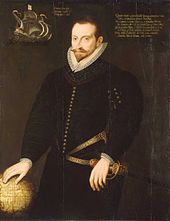
In 1577, Francis Drake set out on an expedition from England to plunder Spanish settlements in South America in search of gold and silver. In the Golden Hind he achieved this but also sailed across the Pacific Ocean in 1579, known then only to the Spanish and Portuguese. Drake eventually sailed into the East Indies and came across the Moluccas, also known as the Spice Islands, and met with Sultan Babullah. In return for linen, gold and silver, a large haul of exotic spices including cloves and Nutmeg were traded – the English initially not knowing of their huge value.[9] Drake returned to England in 1580 and became a celebrated hero; his eventual circumnavigation raised an enormous amount of money for England's coffers, and investors received a return of some 5000 per cent. Thus started what was an important element in the eastern design during the late sixteenth century.[10]
Soon after the defeat of the Spanish Armada in 1588, the captured Spanish and Portuguese ships with their cargoes enabled English voyagers to potentially travel the globe in search of riches.[11] London merchants presented a petition to Queen Elizabeth I for permission to sail to the Indian Ocean.[12] The aim was to deliver a decisive blow to the Spanish and Portuguese monopoly of Far Eastern Trade.[13] Elizabeth granted her permission and on 10 April 1591 James Lancaster in the Bonaventure with two other ships sailed from Torbay around the Cape of Good Hope to the Arabian Sea on one of the earliest English overseas Indian expeditions. Having sailed around Cape Comorin to the Malay Peninsula, they preyed on Spanish and Portuguese ships there before returning to England in 1594.[12]
The biggest capture that galvanised English trade was the seizure of a large Portuguese carrack, the Madre de Deus by Sir Walter Raleigh and the Earl of Cumberland at the Battle of Flores on 13 August 1592.[14] When she was brought in to Dartmouth she was the largest vessel that had been seen in England and her cargo consisted of chests filled with jewels, pearls, gold, silver coins, ambergris, cloth, tapestries, pepper, cloves, cinnamon, nutmeg, benjamin (a tree that produces frankincense), red dye, cochineal and ebony.[15] Equally valuable was the ship's rutter (mariner's handbook) containing vital information on the China, India, and Japan trades. These riches aroused the English to engage in this opulent commerce.[14]
In 1596, three more English ships sailed east but all were lost at sea.[12] A year later however saw the arrival of Ralph Fitch, an adventurer merchant who, along with his companions, had made a remarkable fifteen-year overland journey to Mesopotamia, the Persian Gulf, the Indian Ocean, India and Southeast Asia.[16] Fitch was then consulted on the Indian affairs and gave even more valuable information to Lancaster.[17]
Formation[]
On 22 September 1599, a group of merchants met and stated their intention "to venture in the pretended voyage to the East Indies (the which it may please the Lord to prosper), and the sums that they will adventure", committing £30,133 (over £4,000,000 in today's money).[18][19] Two days later, "the Adventurers" reconvened and resolved to apply to the Queen for support of the project.[19] Although their first attempt had not been completely successful, they nonetheless sought the Queen's unofficial approval to continue. They bought ships for their venture and increased their capital to £68,373.
The Adventurers convened again a year later, on 31 December, and this time they succeeded; the Queen granted a Royal Charter[12] to "George, Earl of Cumberland, and 215 Knights, Aldermen, and Burgesses"[citation needed] under the name Governor and Company of Merchants of London trading into the East Indies.[12] For a period of fifteen years, the charter awarded the newly formed company a monopoly[20] on English trade with all countries east of the Cape of Good Hope and west of the Straits of Magellan.[21] Any traders in breach of the charter without a licence from the company were liable to forfeiture of their ships and cargo (half of which went to the Crown and the other half to the company), as well as imprisonment at the "royal pleasure".[22]
The governance of the company was in the hands of one governor and 24 directors or "committees", who made up the Court of Directors. They, in turn, reported to the Court of Proprietors, which appointed them. Ten committees reported to the Court of Directors. According to tradition, business was initially transacted at the Nags Head Inn, opposite St Botolph's church in Bishopsgate, before moving to India House in Leadenhall Street.[23]
Early voyages to the East Indies[]
Sir James Lancaster commanded the first East India Company voyage in 1601 aboard the Red Dragon.[24] After capturing a rich 1,200 ton Portuguese carrack in the Malacca Straits the trade from the booty enabled the voyagers to set up two "factories" – one at Bantam on Java and another in the Moluccas (Spice Islands) before leaving.[25] They returned to England in 1603 to learn of Elizabeth's death but Lancaster was knighted by the new King James I.[26] By this time, the war with Spain had ended but the company had successfully and profitably breached the Spanish and Portuguese duopoly, with new horizons opened for the English.[13]
In March 1604, Sir Henry Middleton commanded the second voyage. General William Keeling, a captain during the second voyage, led the third voyage aboard the Red Dragon from 1607 to 1610 along with the Hector under Captain William Hawkins and the Consent under Captain David Middleton.[27]
Early in 1608 Alexander Sharpeigh was appointed captain of the company's Ascension, and general or commander of the fourth voyage. Thereafter two ships, Ascension and Union (captained by Richard Rowles) sailed from Woolwich on 14 March 1608.[27] This expedition would be lost.[28]
| Year | Vessels | Total Invested £ | Bullion sent £ | Goods sent £ | Ships & Provisions £ | Notes |
|---|---|---|---|---|---|---|
| 1603 | 3 | 60,450 | 11,160 | 1,142 | 48,140 | |
| 1606 | 3 | 58,500 | 17,600 | 7,280 | 28,620 | |
| 1607 | 2 | 38,000 | 15,000 | 3,400 | 14,600 | Vessels lost |
| 1608 | 1 | 13,700 | 6,000 | 1,700 | 6,000 | |
| 1609 | 3 | 82,000 | 28,500 | 21,300 | 32,000 | |
| 1610 | 4 | 71,581 | 19,200 | 10,081 | 42,500 | |
| 1611 | 4 | 76,355 | 17,675 | 10,000 | 48,700 | |
| 1612 | 1 | 7,200 | 1,250 | 650 | 5,300 | |
| 1613 | 8 | 272,544 | 18,810 | 12,446 | ||
| 1614 | 8 | 13,942 | 23,000 | |||
| 1615 | 6 | 26,660 | 26,065 | |||
| 1616 | 7 | 52,087 | 16,506 |
Initially, the company struggled in the spice trade because of the competition from the already well-established Dutch East India Company. The English company opened a factory in Bantam on Java on its first voyage, and imports of pepper from Java remained an important part of the company's trade for twenty years. The Bantam factory closed in 1683.
Company ships docked at Surat in Gujarat in 1608. The company established its first Indian factory in 1611 at Masulipatnam on the Andhra Coast of the Bay of Bengal; and a second at Surat in 1612. The high profits reported by the company after landing in India initially prompted James I to grant subsidiary licences to other trading companies in England. However, in 1609 he renewed the East India Company's charter for an indefinite period, with the proviso that its privileges would be annulled if trade was unprofitable for three consecutive years.
Foothold in India[]
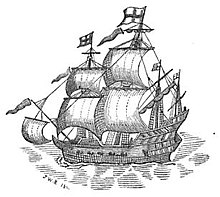

English traders frequently engaged in hostilities with their Dutch and Portuguese counterparts in the Indian Ocean. The company achieved a major victory over the Portuguese in the Battle of Swally in 1612, at Suvali in Surat. The company decided to explore the feasibility of gaining a territorial foothold in mainland India, with official sanction from both Britain and the Mughal Empire, and requested that the Crown launch a diplomatic mission.[29]
In 1612, James I instructed Sir Thomas Roe to visit the Mughal Emperor Nur-ud-din Salim Jahangir (r. 1605–1627) to arrange for a commercial treaty that would give the company exclusive rights to reside and establish factories in Surat and other areas. In return, the company offered to provide the Emperor with goods and rarities from the European market. This mission was highly successful, and Jahangir sent a letter to James through Sir Thomas Roe:[29]
Upon which assurance of your royal love I have given my general command to all the kingdoms and ports of my dominions to receive all the merchants of the English nation as the subjects of my friend; that in what place soever they choose to live, they may have free liberty without any restraint; and at what port soever they shall arrive, that neither Portugal nor any other shall dare to molest their quiet; and in what city soever they shall have residence, I have commanded all my governors and captains to give them freedom answerable to their own desires; to sell, buy, and to transport into their country at their pleasure. For confirmation of our love and friendship, I desire your Majesty to command your merchants to bring in their ships of all sorts of rarities and rich goods fit for my palace; and that you be pleased to send me your royal letters by every opportunity, that I may rejoice in your health and prosperous affairs; that our friendship may be interchanged and eternal.
— Nuruddin Salim Jahangir, Letter to James I.
Expansion[]
The company, which benefited from the imperial patronage, soon expanded its commercial trading operations. It eclipsed the Portuguese Estado da Índia, which had established bases in Goa, Chittagong, and Bombay – Portugal later ceded Bombay to England as part of the dowry of Catherine of Braganza on her marriage to King Charles II. The East India Company also launched a joint attack with the Dutch United East India Company (VOC) on Portuguese and Spanish ships off the coast of China, which helped secure EIC ports in China.[30] The company established trading posts in Surat (1619), Madras (1639), Bombay (1668), and Calcutta (1690). By 1647, the company had 23 factories, each under the command of a factor or master merchant and governor, and 90 employees[clarification needed] in India. The major factories became the walled forts of Fort William in Bengal, Fort St George in Madras, and Bombay Castle.
In 1634, the Mughal emperor Shah Jahan extended his hospitality to the English traders to the region of Bengal,[31] and in 1717 completely waived customs duties for their trade. The company's mainstay businesses were by then cotton, silk, indigo dye, saltpetre, and tea. The Dutch were aggressive competitors and had meanwhile expanded their monopoly of the spice trade in the Straits of Malacca by ousting the Portuguese in 1640–1641. With reduced Portuguese and Spanish influence in the region, the EIC and VOC entered a period of intense competition, resulting in the Anglo-Dutch Wars of the 17th and 18th centuries.
Within the first two decades of the 17th century, the Dutch East India Company or Vereenigde Oostindische Compagnie, (VOC) was the wealthiest commercial operation in the world with 50,000 employees worldwide and a private fleet of 200 ships. It specialised in the spice trade and gave its shareholders 40% annual dividend.[32]
The British East India Company was fiercely competitive with the Dutch and French throughout the 17th and 18th centuries over spices from the Spice Islands. Some spices, at the time, could only be found on these islands, such as nutmeg and cloves; and they could bring profits as high as 400 percent from one voyage.[33]
The tension was so high between the Dutch and the British East Indies Trading Companies that it escalated into at least four Anglo-Dutch Wars:[33] 1652–1654, 1665–1667, 1672–1674 and 1780–1784.
Competition arose in 1635 when Charles I granted a trading licence to Sir William Courteen, which permitted the rival Courteen association to trade with the east at any location in which the EIC had no presence.[34]
In an act aimed at strengthening the power of the EIC, King Charles II granted the EIC (in a series of five acts around 1670) the rights to autonomous territorial acquisitions, to mint money, to command fortresses and troops and form alliances, to make war and peace, and to exercise both civil and criminal jurisdiction over the acquired areas.[35]
In 1689 a Mughal fleet commanded by Sidi Yaqub attacked Bombay. After a year of resistance the EIC surrendered in 1690, and the company sent envoys to Aurangzeb's camp to plead for a pardon. The company's envoys had to prostrate themselves before the emperor, pay a large indemnity, and promise better behaviour in the future. The emperor withdrew his troops, and the company subsequently re-established itself in Bombay and set up a new base in Calcutta.[36]
| Years | EIC | VOC | France | EdI | Denmark | Total | ||||
|---|---|---|---|---|---|---|---|---|---|---|
| Bengal | Madras | Bombay | Surat | EIC (total) | VOC (total) | |||||
| 1665–1669 | 7,041 | 37,078 | 95,558 | 139,677 | 126,572 | 266,249 | ||||
| 1670–1674 | 46,510 | 169,052 | 294,959 | 510,521 | 257,918 | 768,439 | ||||
| 1675–1679 | 66,764 | 193,303 | 309,480 | 569,547 | 127,459 | 697,006 | ||||
| 1680–1684 | 107,669 | 408,032 | 452,083 | 967,784 | 283,456 | 1,251,240 | ||||
| 1685–1689 | 169,595 | 244,065 | 200,766 | 614,426 | 316,167 | 930,593 | ||||
| 1690–1694 | 59,390 | 23,011 | 89,486 | 171,887 | 156,891 | 328,778 | ||||
| 1695–1699 | 130,910 | 107,909 | 148,704 | 387,523 | 364,613 | 752,136 | ||||
| 1700–1704 | 197,012 | 104,939 | 296,027 | 597,978 | 310,611 | 908,589 | ||||
| 1705–1709 | 70,594 | 99,038 | 34,382 | 204,014 | 294,886 | 498,900 | ||||
| 1710–1714 | 260,318 | 150,042 | 164,742 | 575,102 | 372,601 | 947,703 | ||||
| 1715–1719 | 251,585 | 20,049 | 582,108 | 534,188 | 435,923 | 970,111 | ||||
| 1720–1724 | 341,925 | 269,653 | 184,715 | 796,293 | 475,752 | 1,272,045 | ||||
| 1725–1729 | 558,850 | 142,500 | 119,962 | 821,312 | 399,477 | 1,220,789 | ||||
| 1730–1734 | 583,707 | 86,606 | 57,503 | 727,816 | 241,070 | 968,886 | ||||
| 1735–1739 | 580,458 | 137,233 | 66,981 | 784,672 | 315,543 | 1,100,215 | ||||
| 1740–1744 | 619,309 | 98,252 | 295,139 | 812,700 | 288,050 | 1,100,750 | ||||
| 1745–1749 | 479,593 | 144,553 | 60,042 | 684,188 | 262,261 | 946,449 | ||||
| 1750–1754 | 406,706 | 169,892 | 55,576 | 632,174 | 532,865 | 1,165,039 | ||||
| 1755–1759 | 307,776 | 106,646 | 55,770 | 470,192 | 321,251 | 791,443 | ||||
Slavery 1621–1757[]
The East India Company's archives suggest its involvement in the slave trade began in 1684, when a Captain Robert Knox was ordered to buy and transport 250 slaves from Madagascar to St. Helena.[38] The East India Company began using and transporting slaves in Asia and the Atlantic in the early 1620s, according to the Encyclopædia Britannica,[39] or in 1621, according to Richard Allen.[40]
Japan[]

In 1613, during the rule of Tokugawa Hidetada of the Tokugawa shogunate, the British ship Clove, under the command of Captain John Saris, was the first British ship to call on Japan. Saris was the chief factor of the EIC's trading post in Java, and with the assistance of William Adams, a British sailor who had arrived in Japan in 1600, he was able to gain permission from the ruler to establish a commercial house in Hirado on the Japanese island of Kyushu:
We give free license to the subjects of the King of Great Britaine, Sir Thomas Smythe, Governor and Company of the East Indian Merchants and Adventurers forever safely come into any of our ports of our Empire of Japan with their shippes and merchandise, without any hindrance to them or their goods, and to abide, buy, sell and barter according to their own manner with all nations, to tarry here as long as they think good, and to depart at their pleasure.[41]
However, unable to obtain Japanese raw silk for import to China and with their trading area reduced to Hirado and Nagasaki from 1616 onwards, the company closed its factory in 1623.[42]
Anglo Mughal War[]

The first of the Anglo-Indian Wars occurred in 1686 when the company conducted naval code against Shaista Khan, the governor of Mughal Bengal. This later caused the Siege of Bombay and led the intervention of Mughal Emperor Aurangzeb, and ultimately the English company was defeated and fined.[43][44]
Mughal convoy piracy incident of 1695[]
In September 1695, Captain Henry Every, an English pirate on board the Fancy, reached the Straits of Bab-el-Mandeb, where he teamed up with five other pirate captains to make an attack on the Indian fleet on return from the annual pilgrimage to Mecca. The Mughal convoy included the treasure-laden Ganj-i-Sawai, reported to be the greatest in the Mughal fleet and the largest ship operational in the Indian Ocean, and its escort, the Fateh Muhammed. They were spotted passing the straits en route to Surat. The pirates gave chase and caught up with Fateh Muhammed some days later, and meeting little resistance, took some £50,000 to £60,000 worth of treasure.[45]
Every continued in pursuit and managed to overhaul Ganj-i-Sawai, which resisted strongly before eventually striking. Ganj-i-Sawai carried enormous wealth and, according to contemporary East India Company sources, was carrying a relative of the Grand Mughal, though there is no evidence to suggest that it was his daughter and her retinue. The loot from the Ganj-i-Sawai had a total value between £325,000 and £600,000, including 500,000 gold and silver pieces, and has become known as the richest ship ever taken by pirates.[46]
When the news arrived in England it caused an outcry. To appease Aurangzeb, the East India Company promised to pay all financial reparations, while Parliament declared the pirates hostis humani generis ("enemies of the human race"). In mid-1696 the government issued a £500 bounty on Every's head and offered a free pardon to any informer who disclosed his whereabouts. When the East India Company later doubled that reward, the first worldwide manhunt in recorded history was underway.[47]
The plunder of Aurangzeb's treasure ship had serious consequences for the English East India Company. The furious Mughal Emperor Aurangzeb ordered Sidi Yaqub and Nawab Daud Khan to attack and close four of the company's factories in India and imprison their officers, who were almost lynched by a mob of angry Mughals, blaming them for their countryman's depredations, and threatened to put an end to all English trading in India. To appease Emperor Aurangzeb and particularly his Grand Vizier Asad Khan, Parliament exempted Every from all of the Acts of Grace (pardons) and amnesties it would subsequently issue to other pirates.[48]
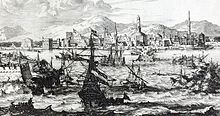
English, Dutch and Danish factories at Mocha
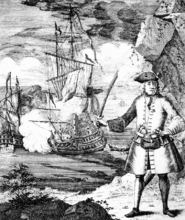
An 18th-century depiction of Henry Every, with the Fancy shown engaging its prey in the background
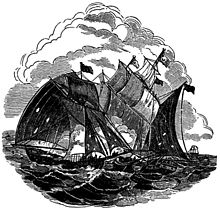
British pirates that fought during the Child's War engaging the Ganj-i-Sawai

Depiction of Captain Every's encounter with the Mughal Emperor's granddaughter after his September 1695 capture of the Mughal trader Ganj-i-Sawai
Afghanistan[]
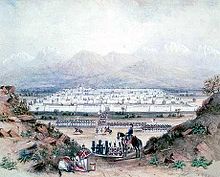
During the Great Game, the East India Company wished to control Afghanistan to prevent a Russian Empire advance through the Afghan mountains towards India, although other motivations were also cited such as fear of a religious uprising in the princely states.[49] The British allied with Afghan emir Dost Mohammad Khan, but following the latter's contacts with the Russians and Qajar Persians to extinguish the Sikh Empire in Punjab, the Company's "Army of the Indus" invaded Afghanistan to put Shah Shujah Durrani on the throne. However following the start of an Afghan insurrection, the Company was forced to retreat from Kabul in 1842 in what became one of the worst British military disasters.[50][51]
Forming a complete monopoly[]
Trade monopoly[]

The prosperity that the officers of the company enjoyed allowed them to return to Britain and establish sprawling estates and businesses, and to obtain political power. The company developed a lobby in the English parliament. Under pressure from ambitious tradesmen and former associates of the company (pejoratively termed Interlopers by the company), who wanted to establish private trading firms in India, a deregulating act was passed in 1694.[52]
This allowed any English firm to trade with India, unless specifically prohibited by act of parliament, thereby annulling the charter that had been in force for almost 100 years. When the East India Company Act 1697 (9 Will. c. 44) was passed in 1697, a new "parallel" East India Company (officially titled the English Company Trading to the East Indies) was floated under a state-backed indemnity of £2 million.[53] The powerful stockholders of the old company quickly subscribed a sum of £315,000 in the new concern, and dominated the new body. The two companies wrestled with each other for some time, both in England and in India, for a dominant share of the trade.[52]
It quickly became evident that, in practice, the original company faced scarcely any measurable competition. The companies merged in 1708, by a tripartite indenture involving both companies and the state, with the charter and agreement for the new United Company of Merchants of England Trading to the East Indies being awarded by Sidney Godolphin, 1st Earl of Godolphin.[54] Under this arrangement, the merged company lent to the Treasury a sum of £3,200,000, in return for exclusive privileges for the next three years, after which the situation was to be reviewed. The amalgamated company became the United Company of Merchants of England Trading to the East Indies.[52]

In the following decades there was a constant battle between the company lobby and Parliament. The company sought a permanent establishment, while Parliament would not willingly allow it greater autonomy and so relinquish the opportunity to exploit the company's profits. In 1712, another act renewed the status of the company, though the debts were repaid. By 1720, 15% of British imports were from India, almost all passing through the company, which reasserted the influence of the company lobby. The licence was prolonged until 1766 by yet another act in 1730.[citation needed]
At this time, Britain and France became bitter rivals. Frequent skirmishes between them took place for control of colonial possessions. In 1742, fearing the monetary consequences of a war, the British government agreed to extend the deadline for the licensed exclusive trade by the company in India until 1783, in return for a further loan of £1 million. Between 1756 and 1763, the Seven Years' War diverted the state's attention towards consolidation and defence of its territorial possessions in Europe and its colonies in North America.[55]
The war took place on Indian soil, between the company troops and the French forces. In 1757, the Law Officers of the Crown delivered the Pratt–Yorke opinion distinguishing overseas territories acquired by right of conquest from those acquired by private treaty. The opinion asserted that, while the Crown of Great Britain enjoyed sovereignty over both, only the property of the former was vested in the Crown.[55]
With the advent of the Industrial Revolution, Britain surged ahead of its European rivals. Demand for Indian commodities was boosted by the need to sustain the troops and the economy during the war, and by the increased availability of raw materials and efficient methods of production. As home to the revolution, Britain experienced higher standards of living. Its spiralling cycle of prosperity, demand and production had a profound influence on overseas trade. The company became the single largest player in the British global market. In 1801 Henry Dundas reported to the House of Commons that
... on the 1st March, 1801, the debts of the East India Company amounted to 5,393,989l. their effects to 15,404,736l. and that their sales had increased since February 1793, from 4,988,300l. to 7,602,041l.[56]
Saltpetre trade[]
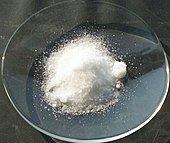
Sir John Banks, a businessman from Kent who negotiated an agreement between the king and the company, began his career in a syndicate arranging contracts for victualling the navy, an interest he kept up for most of his life. He knew that Samuel Pepys and John Evelyn had amassed a substantial fortune from the Levant and Indian trades.
He became a director and later, as governor of the East India Company in 1672, he arranged a contract which included a loan of £20,000 and £30,000 worth of saltpetre—also known as potassium nitrate, a primary ingredient in gunpowder—for the King "at the price it shall sell by the candle"—that is by auction—where bidding could continue as long as an inch-long candle remained alight.[57]
Outstanding debts were also agreed and the company permitted to export 250 tons of saltpetre. Again in 1673, Banks successfully negotiated another contract for 700 tons of saltpetre at £37,000 between the king and the company. So high was the demand from armed forces that the authorities sometimes turned a blind eye on the untaxed sales. One governor of the company was even reported as saying in 1864 that he would rather have the saltpetre made than the tax on salt.[58]
Basis for the monopoly[]
Colonial monopoly[]


The Seven Years' War (1756–1763) resulted in the defeat of the French forces, limited French imperial ambitions, and stunted the influence of the Industrial Revolution in French territories. Robert Clive, the governor-general, led the company to a victory against Joseph François Dupleix, the commander of the French forces in India, and recaptured Fort St George from the French. The company took this respite to seize Manila in 1762.[59][better source needed]
By the Treaty of Paris, France regained the five establishments captured by the British during the war (Pondichéry, Mahe, Karaikal, Yanam and Chandernagar) but was prevented from erecting fortifications and keeping troops in Bengal (art. XI). Elsewhere in India, the French were to remain a military threat, particularly during the War of American Independence, and up to the capture of Pondichéry in 1793 at the outset of the French Revolutionary Wars without any military presence. Although these small outposts remained French possessions for the next two hundred years, French ambitions on Indian territories were effectively laid to rest, thus eliminating a major source of economic competition for the company.
The East India Company had also been granted competitive advantages over colonial American tea importers to sell tea from its colonies in Asia in American colonies. This led to the Boston Tea Party of 1773 in which protesters boarded British ships and threw the tea overboard. When protesters successfully prevented the unloading of tea in three other colonies and in Boston, Governor Thomas Hutchinson of the Province of Massachusetts Bay refused to allow the tea to be returned to Britain. This was one of the incidents which led to the American revolution and independence of the American colonies.[60]
The Company's trade monopoly with India was abolished in the Charter Act of 1813. The monopoly with China was ended in 1833, ending the trading activities of the company and rendering its activities purely administrative.
[]
In its first century and half, the EIC used a few hundred soldiers as guards. The great expansion came after 1750, when it had 3,000 regular troops. By 1763, it had 26,000; by 1778, it had 67,000. It recruited largely Indian troops and trained them along European lines.[61] The military arm of the East India Company quickly developed into a private corporate armed force used as an instrument of geo-political power and expansion instead of its original purpose as a guard force. Because of this, the EIC became the most powerful military force in the Indian subcontinent. As it increased in size, the army was divided into the Presidency Armies of Bengal, Madras and Bombay, each of which recruited its own infantry, cavalry, and artillery units. The company's merchant ships, called East Indiaman were usually well armed to defend against pirates. The EIC also maintained a naval arm called the Bombay Marine; in 1830 this was renamed the Indian Navy.
Opium trade[]

In the 18th century, the EIC had a trade deficit with China, little demand for the companies own manufacture, in China, and a desire to reduce the flow of bullion to China. Dutch and Portuguese merchants had been profitably supplying Batavia, and Canton, with Opium purchased via the Mughal syndicates, of Bengal, Bihar, and Malwa, for over a century, a trade the EIC elected to ape in the early 18th century.[62] On being awarded diwani (revenue collecting) rights in Bengal, in 1765, by the then Mughal emperor Shah Alam I, the EIC identified the existing system of opium syndication as a potential means to increase revenues and reduce the Chinese trade deficit, through inserting itself into the existing system, of issuing licences and advance payments, for opium cultivators entire harvest. With the intention of gaining control of much of Bengals Opium production, setting the purchase price, along with the ability to direct the consumption of Bengali opium. In 1773 the company attempted to monopolise opium syndication in Bengal, by prohibiting the licensing of independent opium cultivators, a decision that yielded additional revenue, despite the widespread illicit cultivation of opium, in the territory it administered, with illicit production estimated to account for over half production in the Presidency, in 1822,[62] and having to compete with Malwa opium, supplied primarily by Sindia and Holkar families, Turkish, and the illicit Bengal and Bihar opium, for the China trade. Licensing and illicit opium cultivation continues till the present day.[63][64]
As the opium trade was illegal in China, Company ships could not carry opium to China. So the opium produced in Bengal was sold in Calcutta on condition that it be exported.[65]
Despite the Chinese ban on opium imports, reaffirmed in 1799 by the Jiaqing Emperor, the companies licensed Opium output was smuggled into China from Bengal by traffickers and agency houses such as Jardine, Matheson & Co, David Sassoon & Co., and Dent & Co. in amounts averaging 900 tons a year. The proceeds of the drug-smugglers landing their cargoes at Lintin Island were paid into the company's factory at Canton and by 1825, most of the money needed to buy tea in China was raised by the illegal opium trade.
The company established a group of trading settlements centred on the Straits of Malacca called the Straits Settlements in 1826 to protect its trade route to China and to combat local piracy. The settlements were also used as penal settlements for Indian civilian and military prisoners.

In 1838 with the amount of smuggled opium entering China approaching 1,400 tons a year, the Chinese imposed a death penalty for opium smuggling and sent a Special Imperial Commissioner, Lin Zexu, to curb smuggling. This resulted in the First Opium War (1839–42). After the war Hong Kong island was ceded to Britain under the Treaty of Nanking and the Chinese market opened to the opium traders of Britain and other nations.[63] The Jardines and Apcar and Company dominated the trade, although P&O also tried to take a share.[66] A Second Opium War fought by Britain, the Companies regiments, and France against China lasted from 1856 until 1860 and led to the Treaty of Tientsin, which legalised the importation of opium. Legalisation stimulated domestic Chinese opium production and increased the importation of opium from Turkey and Persia. This increased competition for the Chinese market led to India's reducing its opium output and diversifying its exports.[63]
Regulation of the company's affairs[]
The British government issues a series of regulations over the years.[67] The Regulating Act of 1773 was the first but did not prove to be a success and subsequently in 1784 the British government passed Pitt's India Act, which created the India Board to regulate the company's governance of India. Following this the government intervened more frequently in Company affairs in a series of East India Company Acts.
Writers[]
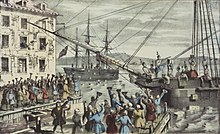
The company employed many junior clerks, known as "writers", to record the details of accounting, managerial decisions, and activities related to the company, such as minutes of meetings, copies of Company orders and contracts, and filings of reports and copies of ship's logs. Several well-known British scholars and literary men had Company writerships, such as Henry Thomas Colebrooke in India and Charles Lamb in England. One Indian writer of some importance in the 19th century was Ram Mohan Roy, who learned English, Sanskrit, Persian, Arabic, Greek, and Latin.[68]
Financial troubles[]
This section needs additional citations for verification. (December 2020) |
The company kept good financial statistics.[69]
Although the company was becoming increasingly bold and ambitious in putting down resisting states, it was becoming clearer that the company was incapable of governing the vast expanse of the captured territories. The Bengal famine of 1770, in which one-third of the local population died, caused distress in Britain. Military and administrative costs mounted beyond control in British-administered regions in Bengal because of the ensuing drop in labour productivity.
At the same time, there was commercial stagnation and trade depression throughout Europe. The directors of the company attempted to avert bankruptcy by appealing to Parliament for financial help. This led to the passing of the Tea Act in 1773, which gave the company greater autonomy in running its trade in the American colonies, and allowed it an exemption from tea import duties which its colonial competitors were required to pay.
When the American colonists and tea merchants were told of this Act, they boycotted the company tea. Although the price of tea had dropped because of the Act, it also validated the Townshend Acts, setting the precedent for the king to impose additional taxes in the future. The arrival of tax-exempt Company tea, undercutting the local merchants, triggered the Boston Tea Party in the Province of Massachusetts Bay, one of the major events leading up to the American Revolution.
Indian Rebellion and disestablishment[]

The Indian Rebellion of 1857 (also known as the Indian Mutiny or Sepoy Mutiny) resulted in widespread devastation in a limited region of north-central India. The crisis began in the Company's army in February, April and May 1857, when scattered mutinies coalesced and to a major revolt. Entire units revolted, killing their British officers and rousing the populace. There was wide support among both Hindu and Muslim elements, ranging from peasants to princes. However the Sikh soldiers supported the British cause. Historians have identified multiple overlapping causes—some recent and some stretching back decades. In 1854 Britain went to war with Russia, but fighting bogged down in the Crimea. London sent many of its best troops to the Crimean front. The extremely bloody stalemate led to widespread rumours to the effect that the army was not nearly as strong as its reputation had claimed. It also opened the possibility of a Russian intervention in India that would overthrow the British—indeed London throughout the 19th century was seriously worried about such a threat. Company leaders had ignored long festering cultural grievances among numerous factions inside India. The Company's army was composed largely of high-caste Hindu gentry, who increasingly resented the deterioration of service conditions. They had learned how to organize and fight but were losing their respect for their British officers. Ambitious peasants resented the rising taxes and the changes in land tenure that made it harder to become successful farmers. At the highest social level princes and their entourages were angry with the systematic takeover of lapsed princedoms where there was no direct heir. Religious anger emerged from the criminalisation of traditional practices. The Hindu suttee (burning widows alive when their husband died) was criminalised and replaced with legalised remarriage. Religious leaders were outraged at this intrusion, and stimulated the formation of Hindu language newspapers which every week attacked the Company. Indian nationalists were angry with Christian missionaries, who were trying to convert the peasants. Muslims who did convert to Christianity were now allowed to inherit from their families, despite the rules against that in Muslim sharia law. The final spark came when the Company introduced new cartridges for its Enfield P53 rifle-muskets, which were supposedly greased with pork and cow fat. To load his rifle the soldier had to bite off the paper, thus horribly polluting himself; both Muslims and Hindus saw a plot to force a mass conversion to Christianity. Historians agree that neither side understood the other, and the Company was unaware that the crisis was building.[70]
British leaders condemned the East India Company for permitting the events to occur.[71] In the aftermath of the Rebellion, under the provisions of the Government of India Act 1858, the British Government nationalised the company. The British government took over its Indian possessions, its administrative powers and machinery, and its armed forces.
The Company had already divested itself of its commercial trading assets in India in favour of the UK government in 1833, with the latter assuming the debts and obligations of the Company, which were to be serviced and paid from tax revenue raised in India. In return, the shareholders voted to accept an annual dividend of 10.5%, guaranteed for forty years, likewise to be funded from India, with a final pay-off to redeem outstanding shares. The debt obligations continued beyond dissolution, and were only extinguished by the UK government during the Second World War.[72]
The company remained in existence in vestigial form, continuing to manage the tea trade on behalf of the British Government (and the supply of Saint Helena) until the East India Stock Dividend Redemption Act 1873 came into effect, on 1 January 1874. This Act provided for the formal dissolution of the company on 1 June 1874, after a final dividend payment and the commutation or redemption of its stock.[73] The Times commented on 8 April 1873:[74]
It accomplished a work such as in the whole history of the human race no other trading Company ever attempted, and such as none, surely, is likely to attempt in the years to come.
Establishments in Britain[]

The company's headquarters in London, from which much of India was governed, was East India House in Leadenhall Street. After occupying premises in Philpot Lane from 1600 to 1621; in Crosby House, Bishopsgate, from 1621 to 1638; and in Leadenhall Street from 1638 to 1648, the company moved into Craven House, an Elizabethan mansion in Leadenhall Street. The building had become known as East India House by 1661. It was completely rebuilt and enlarged in 1726–1729; and further significantly remodelled and expanded in 1796–1800. It was finally vacated in 1860 and demolished in 1861–1862.[75] The site is now occupied by the Lloyd's building.
In 1607, the company decided to build its own ships and leased a yard on the River Thames at Deptford. By 1614, the yard having become too small, an alternative site was acquired at Blackwall: the new yard was fully operational by 1617. It was sold in 1656, although for some years East India Company ships continued to be built and repaired there under the new owners.[76]
In 1803, an Act of Parliament, promoted by the East India Company, established the East India Dock Company, with the aim of establishing a new set of docks (the East India Docks) primarily for the use of ships trading with India. The existing Brunswick Dock, part of the Blackwall Yard site, became the Export Dock; while a new Import Dock was built to the north. In 1838 the East India Dock Company merged with the West India Dock Company. The docks were taken over by the Port of London Authority in 1909, and closed in 1967.[77]

The East India College was founded in 1806 as a training establishment for "writers" (i.e. clerks) in the company's service. It was initially located in Hertford Castle, but moved in 1809 to purpose-built premises at Hertford Heath, Hertfordshire. In 1858 the college closed; but in 1862 the buildings reopened as a public school, now Haileybury and Imperial Service College.[78][79]
The East India Company Military Seminary was founded in 1809 at Addiscombe, near Croydon, Surrey, to train young officers for service in the company's armies in India. It was based in Addiscombe Place, an early 18th-century mansion. The government took it over in 1858, and renamed it the Royal Indian Military College. In 1861 it was closed, and the site was subsequently redeveloped.[80][81]
In 1818, the company entered into an agreement by which those of its servants who were certified insane in India might be cared for at Pembroke House, Hackney, London, a private lunatic asylum run by Dr George Rees until 1838, and thereafter by Dr William Williams. The arrangement outlasted the company itself, continuing until 1870, when the India Office opened its own asylum, the Royal India Asylum, at Hanwell, Middlesex.[82][83]
The East India Club in London was formed in 1849 for officers of the company. The Club still exists today as a private gentlemen's club with its club house situated at 16 St James's Square, London.[84][85]
Legacy and criticisms[]
The East India Company was one of the most powerful and enduring organisations in history and had a long lasting impact on the Indian Subcontinent, with both positive and harmful effects. Although dissolved by the East India Stock Dividend Redemption Act 1873 following the rebellion of 1857, it stimulated the growth of the British Empire. Its professionally trained armies rose to dominate the sub-continent and were to become the armies of British India after 1857. It played a key role in introducing English as an official language in India. This also led to Macaulayism in the Indian subcontinent.

Once the East India Company took over Bengal in the treaty of Allahabad (1765) it collected taxes which it used to further its expansion to the rest of India and did not have to rely on venture capital from London. It returned a high profit to those who risked original money for earlier ventures into Bengal.
During the first century of the East India Company's expansion in India, most people in India lived under regional kings or Nawabs. By the late 18th century many Moghuls were weak in comparison to the rapidly expanding Company as it took over cities and land, and built roads, bridges and railways. Work began in 1849 on the first railway, the Great Indian Peninsula Railway, running for 21 miles (33.8 km) between Bombay (Mumbai) and Tannah (Thane).[86] The Company sought quick profits because the financial backers in England took high risks: their money for possible profits or losses through shipwrecks, wars or calamities.
The increasingly large territory the company was annexing and collecting taxes was also run by the local Nawabs. In essence, it was a dual administration. Between 1765 and 1772 Robert Clive gave the responsibility of tax collecting, diwani, to the Indian deputy and judicial and police responsibilities to other Indian deputies. The Company concentrated its new power of collecting revenue and left the responsibilities to the Indian agencies. The East India Company took the beginning steps of British takeover of power in India for centuries to come. In 1772, the company made Warren Hastings, who had been in India with the Company since 1750, its first governor-general to manage and overview all of the annexed lands. The dual administration system came to an end.
Hastings learned Urdu and Persian and took great interest in preserving ancient Sanskrit manuscripts and having them translated into English. He employed many Indians as officials.[87]
Hastings used Sanskrit texts for Hindus and Arabic texts for Muslims. Hastings also annexed lands and kingdoms and enriched himself in the process. His enemies in London used this against him to have him impeached. (See Impeachment of Warren Hastings.)[88]
Charles Cornwallis, widely remembered as having surrendered to George Washington following the Siege of Yorktown in 1781, replaced Hastings. Cornwallis distrusted Indians and replaced Indians with Britons. He introduced a system of personal land ownership for Indians. This change caused much conflict since most illiterate people had no idea why they suddenly became land renters from land owners.[89]
The Mughals, Marathas and other local rulers often had to choose to fight against the company and lose everything or cooperate with the company and receive a big pension but lose their Empires or Kingdoms. The British East India Company gradually took over most of India by threat, intimidation, bribery or outright war.[90]
The East India Company was the first company to record the Chinese usage of oil of bergamot to flavor tea, which led to the development of Earl Grey tea.[91]
The East India Company introduced a system of merit-based appointments that provided a model for the British and Indian civil service.[92]
Widespread corruption and looting of Bengal resources and treasures during its rule resulted in poverty. A proportion of the loot of Bengal went directly into Clive's pocket.[93] Famines, such as the Great Bengal famine of 1770 and subsequent famines during the 18th and 19th centuries, became more widespread, chiefly because of exploitative agriculture promulgated by the policies of the East India Company and the forced cultivation of opium in place of grain.[94][95] When the Company first arrived, India produced over a third of the world's GDP. Critics have argued the company damaged the Indian economy through exploitive economic policies and looting.[96]
Symbols[]
Flags[]
- Historical depictions

Downman (1685)

Lens (1700)

National Geographic (1917)
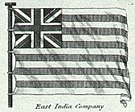
Rees (1820)
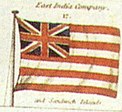
Laurie (1842)
- Modern depictions

1600–1707

1707–1801

1801–1874
The English East India Company flag changed over time, with a canton based on the flag of the contemporary Kingdom, and a field of 9-to-13 alternating red and white stripes.
From 1600, the canton consisted of a St George's Cross representing the Kingdom of England. With the Acts of Union 1707, the canton was changed to the new Union Flag—consisting of an English St George's Cross combined with a Scottish St Andrew's cross—representing the Kingdom of Great Britain. After the Acts of Union 1800 that joined Ireland with Great Britain to form the United Kingdom of Great Britain and Ireland, the canton of the East India Company flag was altered accordingly to include a Saint Patrick's Saltire.
There has been much debate about the number and order of stripes in the field of the flag. Historical documents and paintings show variations from 9-to-13 stripes, with some images showing the top stripe red and others showing it white.
At the time of the American Revolution the East India Company flag was nearly identical to the Grand Union Flag. Historian Charles Fawcett argued that the East India Company Flag inspired the Stars and Stripes of America.[97]
Coat of arms[]
The East India Company's original coat of arms was granted in 1600. The blazon of the arms is as follows:
"Azure, three ships with three masts, rigged and under full sail, the sails, pennants and ensigns Argent, each charged with a cross Gules; on a chief of the second a pale quarterly Azure and Gules, on the 1st and 4th a fleur-de-lis or, on the 2nd and 3rd a leopard or, between two roses Gules seeded Or barbed Vert." The shield had as a crest: "A sphere without a frame, bounded with the Zodiac in bend Or, between two pennants flottant Argent, each charged with a cross Gules, over the sphere the words Deus indicat" (Latin: God Indicates). The supporters were two sea lions (lions with fishes' tails) and the motto was Deo ducente nil nocet (Latin: Where God Leads, Nothing Harms).[98]
The East India Company's later arms, granted in 1698, were: "Argent a cross Gules; in the dexter chief quarter an escutcheon of the arms of France and England quarterly, the shield ornamentally and regally crowned Or." The crest was: "A lion rampant guardant Or holding between the forepaws a regal crown proper." The supporters were: "Two lions rampant guardant Or, each supporting a banner erect Argent, charged with a cross Gules." The motto was Auspicio regis et senatus angliæ (Latin: Under the auspices of the King and the Senate of England).[98]
Merchant mark[]
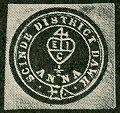
HEIC Merchant's mark on a Blue Scinde Dawk postage stamp (1852)
When the East India Company was chartered in 1600, it was still customary for individual merchants or members of companies such as the Company of Merchant Adventurers to have a distinguishing merchant's mark which often included the mystical "Sign of Four" and served as a trademark. The East India Company's merchant mark consisted of a "Sign of Four" atop a heart within which was a saltire between the lower arms of which were the initials "EIC". This mark was a central motif of the East India Company's coinage[99] and forms the central emblem displayed on the Scinde Dawk postage stamps.[100]
Ships[]
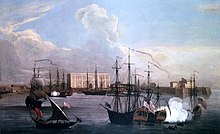
Ships of the East India Company were called East Indiamen or simply "Indiamen".[101] Their names were sometimes prefixed with the initials "HCS", standing for "Honourable Company's Service"[102] or "Honourable Company's Ship",[103] such as HCS Vestal (1809) and HCS Intrepid (1780).

During the French Revolutionary and Napoleonic Wars, the East India Company arranged for letters of marque for its vessels such as Lord Nelson. This was not so that they could carry cannon to fend off warships, privateers, and pirates on their voyages to India and China (that they could do without permission) but so that, should they have the opportunity to take a prize, they could do so without being guilty of piracy. Similarly, the Earl of Mornington, an East India Company packet ship of only six guns, also sailed under a letter of marque.
In addition, the company had its own navy, the Bombay Marine, equipped with warships such as Grappler. These vessels often accompanied vessels of the Royal Navy on expeditions, such as the Invasion of Java.
At the Battle of Pulo Aura, which was probably the company's most notable naval victory, Nathaniel Dance, Commodore of a convoy of Indiamen and sailing aboard the Warley, led several Indiamen in a skirmish with a French squadron, driving them off. Some six years earlier, on 28 January 1797, five Indiamen, Woodford, under Captain Charles Lennox, Taunton-Castle, Captain Edward Studd, Canton, Captain Abel Vyvyan, Boddam, Captain George Palmer, and Ocean, Captain John Christian Lochner, had encountered Admiral de Sercey and his squadron of frigates. On this occasion the Indiamen succeeded in bluffing their way to safety, and without any shots even being fired. Lastly, on 15 June 1795, General Goddard played a large role in the capture of seven Dutch East Indiamen off St Helena.
East Indiamen were large and strongly built and when the Royal Navy was desperate for vessels to escort merchant convoys it bought several of them to convert to warships. Earl of Mornington became HMS Drake. Other examples include:
- HMS Calcutta
- HMS Glatton
- HMS Hindostan
- HMS Hindostan
- HMS Malabar
- HMS Buffalo
Their design as merchant vessels meant that their performance in the warship role was underwhelming and the Navy converted them to transports.
Records[]
Unlike all other British Government records, the records from the East India Company (and its successor the India Office) are not in The National Archives at Kew, London, but are held by the British Library in London as part of the Asia, Pacific and Africa Collections. The catalogue is searchable online in the Access to Archives catalogues.[104] Many of the East India Company records are freely available online under an agreement that the Families in British India Society has with the British Library. Published catalogues exist of East India Company ships' journals and logs, 1600–1834;[105] and of some of the company's daughter institutions, including the East India Company College, Haileybury, and Addiscombe Military Seminary.[79]
The Asiatic Journal and Monthly Register for British India and its Dependencies, first issued in 1816, was sponsored by the East India Company, and includes much information relating to the EIC.
Early Governors[]
- 1600–1601 : Sir Thomas Smythe (first Governor)
- 1601–1602 : Sir John Watts
- 1602–1603 : Sir John Harts
- 1606–1607 : Sir William Romney
- 1607–1621 : Sir Thomas Smythe
- 1621–1624 : Sir William Halliday
- 1624–1638 : Sir Maurice (Morris) Abbot
- 1638–1641 : Sir Christopher Clitherow
See also[]
East India Company[]
- Company rule in India
- Economy of India under Company rule
- Governor-General of India
- Chief Justice of Bengal
- Advocate-General of Bengal
- Chief Justice of Madras
- Indian Rebellion of 1857
- Indian independence movement
- List of East India Company directors
- List of trading companies
- East India Company Cemetery in Macau
- Category:Honourable East India Company regiments
General[]
- British Imperial Lifeline
- Lascar
- Carnatic Wars
- Commercial Revolution
- Political warfare in British colonial India
- Trade between Western Europe and the Mughal Empire in the 17th century
- Whampoa anchorage
Notes and references[]
- ^ Carey, W. H. (1882). 1882 – The Good Old Days of Honourable John Company. Simla: Argus Press. Retrieved 30 July 2015.
- ^ "Company Bahadur". Encyclopaedia Britannica.
- ^ The Dutch East India Company was the first to issue public stock.
- ^ Henige, David P. (1970). Colonial governors from the fifteenth century to the present : a comprehensive list. University of Wisconsin Press. ISBN 0-299-05440-3. OCLC 299459478.
- ^ Scott, William. "East India Company, 1817-1827". archiveshub.jisc.ac.uk. Senate House Library Archives, University of London. Archived from the original on 1994. Retrieved 20 September 2019.
- ^ Parliament of England (31 December 1600). "Charter granted by Queen Elizabeth to the East India Company". en.wikisource.org. Wikimedia. Retrieved 20 September 2019.
Governor and Company of Merchants of London, Trading into the East-Indies
- ^ Jump up to: a b Farrington, Anthony (2002). Trading Places: The East India Company and Asia 1600–1834. British Library. ISBN 9780712347563. Retrieved 21 September 2019.
- ^ "Books associated with Trading Places – the East India Company and Asia 1600–1834, an Exhibition". Archived from the original on 30 March 2014.
- ^ Wheeler, Jack (21 August 2017). "Sir Francis Drake and the Sultan". International Strategies For the Globally Minded. Escape Artist.
- ^ Lawson 1993, p. 2
- ^ Desai, Tripta (1984). The East India Company: A Brief Survey from 1599 to 1857. Kanak Publications. p. 3.
- ^ Jump up to: a b c d e "Early European Settlements". Imperial Gazetteer of India. II. 1908. p. 454.
- ^ Jump up to: a b Wernham, R.B (1994). The Return of the Armadas: The Last Years of the Elizabethan Wars Against Spain 1595–1603. Oxford: Clarendon Press. pp. 333–334. ISBN 978-0-19-820443-5.
- ^ Jump up to: a b McCulloch, John Ramsay (1833). A Treatise on the Principles, Practice, & History of Commerce. Baldwin and Cradock. p. 120.
- ^ Leinwand 2006, pp. 125–127.
- ^ 'Ralph Fitch: An Elizabethan Merchant in Chiang Mai; and 'Ralph Fitch's Account of Chiang Mai in 1586–1587' in: Forbes, Andrew, and Henley, David, Ancient Chiang Mai Volume 1. Chiang Mai, Cognoscenti Books, 2012.
- ^ Prasad, Ram Chandra (1980). Early English Travellers in India: A Study in the Travel Literature of the Elizabethan and Jacobean Periods with Particular Reference to India. Motilal Banarsidass. p. 45. ISBN 9788120824652.
- ^ Wilbur, Marguerite Eyer (1945). The East India Company: And the British Empire in the Far East. Stanford, Cal.: Stanford University Press. p. 18. ISBN 978-0-8047-28645.
- ^ Jump up to: a b "East Indies: September 1599". british-history.ac.uk. Retrieved 18 February 2017.
- ^ The Imperial Gazetteer of India. II: The Indian Empire, Historical. Oxford: Clarendon Press. 1908. p. 455.
- ^ "East India Company - Encyclopedia". theodora.com. Retrieved 26 March 2021.
- ^ Kerr, Robert (1813). A General History and Collection of Voyages and Travels. 8. W. Blackwood. p. 102.
- ^ Timbs, John (1855). Curiosities of London: Exhibiting the Most Rare and Remarkable Objects of Interest in the Metropolis. D. Bogue. p. 264.
- ^ Gardner, Brian (1990) [1971]. The East India Company: A History. Dorset Press. pp. 23–24. ISBN 978-0-88029-530-7.
- ^ Dulles (1969), p106.
- ^ Foster, Sir William (1998). England's quest of eastern trade (1933 ed.). London: A. & C. Black. p. 157. ISBN 9780415155182.
- ^ Jump up to: a b East India Company (1897). List of Factory Records of the late East India Company: preserved in the Record Department of the India Office, London. p. vi.
- ^ Jump up to: a b James Mill (1817). "1". The History of British India. Baldwin, Cradock, and Joy. pp. 15–18. Retrieved 30 July 2018.
- ^ Jump up to: a b The battle of Plassey ended the tax on the Indian goods. "Indian History Sourcebook: England, India, and The East Indies, 1617 CE". Fordham University.
- ^ Tyacke, Sarah (2008). "Gabriel Tatton's Maritime Atlas of the East Indies, 1620–1621: Portsmouth Royal Naval Museum, Admiralty Library Manuscript, MSS 352". Imago Mundi. 60 (1): 39–62. doi:10.1080/03085690701669293. S2CID 162239597.
- ^ Dalrymple, William (24 August 2019). "East India Company sent a diplomat to Jahangir & all the Mughal Emperor cared about was beer".
- ^ "The Nutmeg Wars". Neatorama.
- ^ Jump up to: a b Suijk, Paul (Director) (2015). 1600 The British East India Company [The Great Courses (Episode 5, 13:16] (on-line video). Brentwood Associates/The Teaching Company Sales. Chantilly, VA, USA: Liulevicius, Professor Vejas Gabriel (lecturer).
- ^ Riddick, John F. (2006). The history of British India: a chronology. Greenwood Publishing Group. p. 4. ISBN 978-0-313-32280-8.
- ^ "East India Company" (1911). Encyclopædia Britannica Eleventh Edition, Volume 8, p.835
- ^ "Asia facts, information, pictures – Encyclopedia.com articles about Asia". encyclopedia.com. Retrieved 7 July 2017.
- ^ Broadberry, Stephen; Gupta, Bishnupriya. "The Rise, Organization, and Institutional Framework of Factor Markets". International Institute of Social history. Retrieved 7 August 2018.
- ^ Pinkston, Bonnie (3 October 2018). "Documenting the British East India Company and their Involvement in the East Indian Slave Trade". SLIS Connecting. 7 (1): 53–59. doi:10.18785/slis.0701.10. ISSN 2330-2917.
- ^ "East India Company | Definition, History, & Facts". Encyclopedia Britannica. Retrieved 21 June 2020.
- ^ Allen, Richard B. (2015). European Slave Trading in the Indian Ocean, 1500–1850. Athens, Ohio: Ohio University Press. ISBN 9780821421062.
- ^ Wilbur, Marguerite Eyer (1945). The East India Company: And the British Empire in the Far East. Stanford University Press. pp. 82–83. ISBN 978-0-8047-2864-5.
- ^ Hayami, Akira (2015). Japan's Industrious Revolution: Economic and Social Transformations in the Early Modern Period. Springer. p. 49. ISBN 978-4-431-55142-3.
- ^ Hasan, Farhat (1991). "Conflict and Cooperation in Anglo-Mughal Trade Relations during the Reign of Aurangzeb". Journal of the Economic and Social History of the Orient. 34 (4): 351–360. doi:10.1163/156852091X00058. JSTOR 3632456.
- ^ Vaugn, James (September 2017). "John Company Armed: The English East India Company, the Anglo-Mughal War and Absolutist Imperialism, c. 1675–1690". Britain and the World. 11 (1).
- ^ Burgess, Douglas R (2009). The Pirates' Pact: The Secret Alliances Between History's Most Notorious Buccaneers and Colonial America. New York: McGraw-Hill. ISBN 978-0-07-147476-4.
- ^ Sims-Williams, Ursula. "The highjacking of the Ganj-i Sawaʼi". The British Library. Retrieved 16 June 2020.
- ^ Burgess 2009, p. 144
- ^ Fox, E. T. (2008). King of the Pirates: The Swashbuckling Life of Henry Every. London: Tempus Publishing. ISBN 978-0-7524-4718-6.
- ^ Husain, Farrukh (2018). Afghanistan in the age of empires: the great game for South and Central Asia. Silk Road Books. pp. 81, 412. ISBN 978-1-5272-1633-4.
- ^ McNamara, Robert (6 December 2019). "Britain's Disastrous Retreat from Kabul". Thoughtco. Retrieved 23 August 2021.
- ^ Siddique, Abubakar (22 February 2013). "The Perils of Invading Afghanistan". The Atlantic. Retrieved 23 August 2021.
- ^ Jump up to: a b c "The British East India Company – the Company that Owned a Nation (or Two)". victorianweb.org.
- ^ Boggart, Dan (2017). Lamoreaux, Naomi R.; Wallis, John Joseph (eds.). "East Indian Monopoly and Limited Access in England". Organizations, Civil Society, and the Roots of Development. Chicago: University of Chicago Press.
- ^ Company, East India; Shaw, John (1887). Charters Relating to the East India Company from 1600 to 1761: Reprinted from a Former Collection with Some Additions and a Preface for the Government of Madras. R. Hill at the Government Press. p. 217.
- ^ Jump up to: a b Thomas, P. D. G. (2008) "Pratt, Charles, first Earl Camden (1714–1794)", Oxford Dictionary of National Biography, Oxford University Press, online edn. Retrieved 15 February 2008 (subscription or UK public library membership required)
- ^ Pyne, William Henry (1904) [1808]. The Microcosm of London, or London in Miniature. 2. London: Methuen. p. 159.
- ^ Janssens, Koen (2009). Annales Du 17e Congrès D'Associationi Internationale Pour L'histoire Du Verre. Asp / Vubpress / Upa. p. 366. ISBN 978-90-5487-618-2.
- ^ "SALTPETER the secret salt – Salt made the world go round". salt.org.il. Retrieved 7 July 2017.
- ^ "The Seven Years' War in the Philippines". Land Forces of Britain, the Empire and Commonwealth. Archived from the original on 10 July 2004. Retrieved 4 September 2013.
- ^ Mitchell, Stacy. The big box swindle. Retrieved 20 April 2018.
- ^ Gerald Bryant (1978). "Officers of the East India Company's army in the days of Clive and Hastings". The Journal of Imperial and Commonwealth History. 6 (3): 203–227. doi:10.1080/03086537808582508.
- ^ Jump up to: a b Cederlöf, Gunnel (3 October 2018). "Poor Man's Crop: Evading opium monopoly". Modern Asian Studies. 53 (2): 633–659. doi:10.1017/S0026749X17001093. ISSN 0026-749X.
- ^ Jump up to: a b c Windle, James (2012). "Insights for Contemporary Drug Policy: A Historical Account of Opium Control in India and Pakistan" (PDF). Asian Journal of Criminology. 7 (1): 55–74. doi:10.1007/s11417-011-9104-0. S2CID 144113092.
- ^ "Illegal opium farming on Jaipur outskirts, 13 cases found in a year: Police". Hindustan Times. 10 March 2021. Retrieved 1 September 2021.
- ^ "EAST INDIA COMPANY FACTORY RECORDS Sources from the British Library, LondonPart 1: China and Japan". ampltd.co.uk. Retrieved 7 July 2017.
- ^ Harcourt, Freda (2006). Flagships of Imperialism: The P & O Company and the Politics of Empire from Its Origins to 1867. Manchester University Press. p. 103. ISBN 978-1-84779-145-0.
- ^ Huw Vaughan Bowen, The business of empire: the East India Company and imperial Britain, 1756–1833 (Cambridge University Press, 2005).
- ^ Suijk, Paul (Director) (2015). The British East India Company [The Great Courses (Episode 24, 7:38–4:33)] (on-line video). Brentwood Associates/The Teaching Company Sales. Chantilly, VA, USA: Fisher, Professor Michael H (lecturer).
- ^ Huw Bowen, "East India Company: trade and domestic financial statistics, 1755–1838." UK Data Archive, Data.
- ^ Robert Tombs, The English and their History (2015) pp 564-568.
- ^ David, Saul (2003). The Indian Mutiny: 1857 (4th ed.). London: Penguin. ISBN 978-0-14-100554-6.
- ^ Robins, Nick (2012), "A Skulking Power", The Corporation That Changed the World, How the East India Company Shaped the Modern Multinational, Pluto Press, pp. 171–198, ISBN 978-0-7453-3195-9, JSTOR j.ctt183pcr6.16, retrieved 30 January 2021
- ^ East India Stock Dividend Redemption Act 1873 (36 & 37 Vict. 17) s. 36: "On the First day of June One thousand eight hundred and seventy-four, and on payment by the East India Company of all unclaimed dividends on East India Stock to such accounts as are herein-before mentioned in pursuance of the directions herein-before contained, the powers of the East India Company shall cease, and the said Company shall be dissolved." Where possible, the stock was redeemed through commutation (i.e. exchanging the stock for other securities or money) on terms agreed with the stockholders (ss. 5–8), but stockholders who did not agree to commute their holdings had their stock compulsorily redeemed on 30 April 1874 by payment of £200 for every £100 of stock held (s. 13).
- ^ "Not many days ago the House of Commons passed". Times. London. 8 April 1873. p. 9.
- ^ Foster, Sir William (1924). The East India House: its History and Associations. London: John Lane.
- ^ Hobhouse, Hermione, ed. (1994). "Blackwall Yard". Poplar, Blackwall and Isle of Dogs: the parish of All Saints. Survey of London. 44. London: Athlone Press/Royal Commission on the Historical Monuments of England. pp. 553–565. ISBN 9780485482447 – via British History Online.
- ^ Hobhouse, Hermione, ed. (1994). "The East India Docks". Poplar, Blackwall and Isle of Dogs: the parish of All Saints. Survey of London. 44. London: Athlone Press/Royal Commission on the Historical Monuments of England. pp. 575–582. ISBN 9780485482447 – via British History Online.
- ^ Danvers, Frederick Charles; Martineau, Harriet; Monier-Williams, Monier; Bayley, Steuart Colvin; Wigram, Percy; Sapte, Brand (1894). Memorials of Old Haileybury College. Westminster: Archibald Constable.
- ^ Jump up to: a b Farrington 1976.
- ^ Vibart, H. M. (1894). Addiscombe: its heroes and men of note. Westminster: Archibald Constable. OL 23336661M.
- ^ Farrington 1976, pp. pp. 111–23.
- ^ Farrington 1976, pp. 125–132.
- ^ Bolton, Diane K.; Croot, Patricia E. C.; Hicks, M. A. (1982). "Ealing and Brentford: Public services". In Baker, T. F. T.; Elrington, C. R. (eds.). A History of the County of Middlesex: Volume 7, Acton, Chiswick, Ealing and Brentford, West Twyford, Willesden. London: Victoria County History. pp. 147–149.
- ^ "East India Club". Archived from the original on 11 January 2012. Retrieved 7 January 2012.
- ^ Forrest, Denys Mostyn (1982). Foursome in St James's: the story of the East India, Devonshire, Sports, and Public Schools Club. London: East India, Devonshire, Sports and Public Schools Club.
- ^ Rao, M.A. (1988). Indian Railways, New Delhi: National Book Trust, p.15.
- ^ Suijk, Paul (Director) (2015). The British East India Company [The Great Courses (Episode 24,19:11)] (on-line video). Brentwood Associates/The Teaching Company Sales. Chantilly, VA, USA: Fisher, Professor Michael H (lecturer).
- ^ Suijk, Paul (Director) (2015). The British East India Company [The Great Courses (Episode 24,17:27)] (on-line video). Brentwood Associates/The Teaching Company Sales. Chantilly, VA, USA: Fisher, Professor Michael H (lecturer).
- ^ Suijk, Paul (Director) (2015). The British East India Company [The Great Courses (Episode 24,16:00)] (on-line video). Brentwood Associates/The Teaching Company Sales. Chantilly, VA, USA: Fisher, Professor Michael H (lecturer).
- ^ Suijk, Paul (Director) (2015). The British East India Company [The Great Courses (Episode 24, 9:27)] (on-line video). Brentwood Associates/The Teaching Company Sales. Chantilly, VA, USA: Fisher, Professor Michael H (lecturer).
- ^ "Bringing back John Company". The Hindu. Archived from the original on 1 July 2003.
- ^ "The Company that ruled the waves", in The Economist, 17–30 December 2011, p. 111.
- ^ Dalrymple, William (4 March 2015). "The East India Company: The original corporate raiders". The Guardian. Retrieved 8 June 2017.
- ^ Davis, Mike. Late Victorian Holocausts. The New York Times. Retrieved 6 June 2015.
- ^ Moxham, Roy. "Lecture: THE EAST INDIA COMPANY'S SEIZURE OF BENGAL AND HOW THIS LED TO THE GREAT BENGAL FAMINE OF 1770". You Tube. Brick Lane Circle. Retrieved 6 June 2015.
- ^ Bharucha, Nauzer (10 November 2019). "The English looted India, and they looted the word 'loot'". Times News Network. Retrieved 12 November 2019.
- ^ Fawcett, Charles (30 July 2013). Rob Raeside (ed.). "The Striped Flag of the East India Company, and its Connexion with the American "Stars and Stripes"".
- ^ Jump up to: a b "East India Company". Hubert Herald. Retrieved 10 February 2014.
- ^ East India Company coin 1791, half pice, as illustrated.
- ^ "Scinde District Dawks". 27 October 2009. Archived from the original on 27 October 2009.
- ^ Sutton, Jean (1981) Lords of the East: The East India Company and Its Ships. London: Conway Maritime
- ^ "Dictionary & Glossary". India Office Family History Search. British Library. Retrieved 5 August 2021.
- ^ Anderson, Ross (2014). "New source for EIC vessel and crew lost on the Western Australian coast". The Great Circle. Australian Association for Maritime History. 36 (1): 33–38. ISSN 0156-8698. JSTOR 24583017. Retrieved 5 August 2021.
- ^ "The Discovery Service". discovery.nationalarchives.gov.uk.
- ^ Farrington, Anthony, ed. (1999). Catalogue of East India Company ships' journals and logs: 1600–1834. London: British Library. ISBN 978-0-7123-4646-7.
- ^ The Emergence of International Business, 1200–1800: The English East India Company. p. Appendix.
Further reading[]
- Andrews, Kenneth R. (1985). Trade, Plunder, and Settlement: Maritime Enterprise and the Genesis of the British Empire, 1480–1630. Cambridge, UK: Cambridge University Press. ISBN 978-0-521-25760-2.
- Bowen, H. V. (1991). Revenue and Reform: The Indian Problem in British Politics, 1757–1773. Cambridge, UK: Cambridge University Press. ISBN 978-0-521-40316-0.
- Bowen, H. V. (2003). Margarette Lincoln; Nigel Rigby (eds.). The Worlds of the East India Company. Rochester, NY: Brewer. ISBN 978-0-85115-877-8.; 14 essays by scholars
- Brenner, Robert (1993). Merchants and Revolution: Commercial Change, Political Conflict, and London's Overseas Traders, 1550–1653. Princeton, NJ: Princeton University Press. ISBN 978-0-691-05594-7.
- Carruthers, Bruce G. (1996). City of Capital: Politics and Markets in the English Financial Revolution. Princeton, NJ: Princeton University Press. ISBN 978-0-691-04455-2.
- Chaudhuri, K. N. (1965). The English East India Company: The Study of an Early Joint-Stock Company, 1600–1640. London: Cass.
- Chaudhuri, K. N. (1978). The Trading World of Asia and the English East India Company, 1660–1760. Cambridge, UK: Cambridge University Press. ISBN 978-0-521-21716-3.
- Chaudhury, S. (1999). Merchants, Companies, and Trade: Europe and Asia in the Early Modern Era. London: Cambridge University Press.
- Collins, G. M. (2019). "The Limits of Mercantile Administration: Adam Smith and Edmund Burke on Britain's East India Company" Journal of the History of Economic Thought, 41(3), 369-392.
- Dalrymple, William (March 2015). The East India Company: The original corporate raiders. "For a century, the East India Company conquered, subjugated and plundered vast tracts of south Asia. The lessons of its brutal reign have never been more relevant." The Guardian
- William Dalrymple The Anarchy – The Relentless Rise of the East India Company, Bloomsbury, London, 2019, ISBN 978-1-4088-6437-1.
- Dirks, Nicholas (2006). The Scandal of Empire: India and the creation of Imperial Britain. Cambridge, Massachusetts, London, England: The Belknap Press of Harvard University Press. ISBN 978-0-674-02166-2.
- Dann, John (2019). Mr Bridgman's Accomplice -Long Ben's Coxswain 1660-1722. ISBN 978-178456-636-4.
- Dodwell, Henry. Dupleix and Clive: Beginning of Empire. (1968).
- Dulles, Foster Rhea (1931). Eastward ho! The first English adventurers to the Orient (1969 ed.). Freeport, New York: Books for Libraries Press. ISBN 978-0-8369-1256-2.
- Farrington, Anthony (2002). Trading Places: The East India Company and Asia, 1600–1834. London: British Library. ISBN 978-0-7123-4756-3.
- Finn, Margot; Smith, Kate, eds. (2018). The East India Company at Home, 1757–1857. London: UCL Press. ISBN 978-1-78735-028-1.
- Furber, Holden. John Company at Work: A study of European Expansion in India in the late Eighteenth century (Harvard University Press, 1948)
- Furber, Holden (1976). Rival Empires of Trade in the Orient, 1600–1800. Minneapolis: University of Minnesota Press. ISBN 978-0-8166-0787-7.
- Gardner, Brian. The East India Company : a history (1990) Online free to borrow
- Greenwood, Adrian (2015). Victoria's Scottish Lion: The Life of Colin Campbell, Lord Clyde. UK: History Press. p. 496. ISBN 978-0-7509-5685-7.
- Harrington, Jack (2010), Sir John Malcolm and the Creation of British India, New York: Palgrave Macmillan., ISBN 978-0-230-10885-1
- Hutková, K. (2017). "Technology transfers and organization: the English East India Company and the transfer of Piedmontese silk reeling technology to Bengal, 1750s–1790s" Enterprise & Society, 18(4), 921-951.
- Keay, John (2010). The Honourable Company: A History of the English East India Company. HarperCollins UK. ISBN 978-0-00-739554-5.
- Kumar, Deepak. (2017) The evolution of colonial science in India: natural history and the East India Company." Imperialism and the natural world (Manchester University Press, 2017).
- Lawson, Philip (1993). The East India Company: A History. London: Longman. ISBN 978-0-582-07386-9.
- Leinwand, Theodore B. (2006). Theatre, Finance and Society in Early Modern England. Cambridge University. ISBN 978-0-521-03466-1.
- McAleer, John. (2017). Picturing India: People, Places, and the World of the East India Company (University of Washington Press).
- MacGregor, Arthur (2018). Company Curiosities: nature, culture and the East India Company, 1600–1874. London: Reaktion Books. ISBN 9781789140033.
- Marshall, P. J. Problems of empire: Britain and India 1757–1813 (1968) Online free to borrow
- Misra, B. B. The Central Administration of the East India Company, 1773–1834 (1959)
- O'Connor, Daniel (2012). The Chaplains of the East India Company, 1601–1858. London: Continuum. ISBN 978-1-4411-7534-2.
- Oak, Mandar, and Anand V. Swamy. "Myopia or strategic behavior? Indian regimes and the East India Company in late eighteenth century India." Explorations in economic history 49.3 (2012): 352–366.
- Philips, C. H. The East India Company 1784–1834 (2nd ed. 1961), on its internal workings.
- Raman, Bhavani. "Sovereignty, property and land development: the East India Company in Madras." Journal of the Economic and Social History of the Orient 61.5-6 (2018): 976-1004.
- Rees, L. A. (2017). Welsh sojourners in India: the East India Company, networks and patronage, c. 1760–1840. Journal of Imperial and Commonwealth History, 45(2), 165-187.
- Riddick, John F. The history of British India: a chronology (2006), covers 1599–1947
- Riddick, John F. Who Was Who in British India (1998), covers 1599–1947
- Ruffner, Murray (21 April 2015). "Selden Map Atlas". Thinking Past. Retrieved 28 April 2015.
- Risley, Sir Herbert H., ed. (1908), The Indian Empire: Historical, Imperial Gazetteer of India, 2, Oxford: Clarendon Press, under the authority of H.M. Secretary of State for India
- Risley, Sir Herbert H., ed. (1908), The Indian Empire: Administrative, Imperial Gazetteer of India, 4, Oxford: Clarendon Press, under the authority of H.M Secretary of State for India
- Robins, Nick (December 2004). The world's first multinational, in the New Statesman
- Robins, Nick (2006). The Corporation that Changed the World: How the East India Company Shaped the Modern Multinational. London: Pluto Press. ISBN 978-0-7453-2524-8.
- Sen, Sudipta (1998). Empire of Free Trade: The East India Company and the Making of the Colonial Marketplace. Philadelphia: University of Pennsylvania Press. ISBN 978-0-8122-3426-8.
- Sharpe, Brandon (23 April 2015). "Selden Map Atlas". Thinkingpast.com. Retrieved 28 April 2015.
- St. John, Ian. The Making of the Raj: India Under the East India Company (ABC-CLIO, 2011)
- Steensgaard, Niels (1975). The Asian Trade Revolution of the Seventeenth Century: The East India Companies and the Decline of the Caravan Trade. Chicago: University of Chicago Press. ISBN 978-0-226-77138-0.
- Stern, Philip J. The Company-State: Corporate Sovereignty and the Early Modern Foundations of the British Empire in India (2011)
- Sutherland, Lucy S. "The East India Company in Eighteenth-Century Politics." Economic History Review 17.1 (1947): 15–26. online
- Sutherland, Lucy S. (1952). The East India Company in Eighteenth-Century Politics. Oxford: Clarendon Press.
- Vaughn, J. M. (2019). The Politics of Empire at the Accession of George III: The East India Company and the Crisis and Transformation of Britain's Imperial State (Lewis Walpole Series in Eighteenth-Century Culture and History).
- Williams, Roger (2015). London's Lost Global Giant: In Search of the East India Company. London: Bristol Book Publishing. ISBN 978-0-9928466-2-6.
Historiography[]
- Farrington, Anthony, ed. (1976). The Records of the East India College, Haileybury, & other institutions. London: H.M.S.O.
- Stern, Philip J. (2009). "History and historiography of the English East India Company: Past, present, and future!". History Compass. 7 (4): 1146–1180. doi:10.1111/j.1478-0542.2009.00617.x.
- Van Meersbergen, G. (2017). "Writing East India Company History after the Cultural Turn: Interdisciplinary Perspectives on the Seventeenth-Century East India Company and Verenigde Oostindische Compagnie." Journal for Early Modern Cultural Studies, 17(3), 10-36. online
External links[]
| Wikimedia Commons has media related to British East India Company. |
- Charter of 1600
- East India Company on In Our Time at the BBC
- Seals and Insignias of East India Company
- The Secret Trade The basis of the monopoly.
- Trading Places – a learning resource from the British Library
- Port Cities: History of the East India Company
- Ships of the East India Company
- Plant Cultures: East India Company in India
- History and Politics: East India Company
- Nick Robins, "The world's first multinational", 13 December 2004, New Statesman
- East India Company: Its History and Results article by Karl Marx, MECW Volume 12, p. 148 in Marxists Internet Archive
- Text of East India Company Act 1773
- Text of East India Company Act 1784
- "The East India Company – a corporate route to Europe" on BBC Radio 4's In Our Time featuring Huw Bowen, Linda Colley and Maria Misra
- HistoryMole Timeline: The British East India Company
- William Howard Hooker Collection: East Indiaman Thetis Logbook (#472-003), East Carolina Manuscript Collection, J. Y. Joyner Library, East Carolina University
- British East India Company
- British colonisation of Asia
- British Ceylon
- British Malaya
- British rule in Singapore
- British Indian history
- Colonial Indian companies
- Chartered companies
- Defunct companies of England
- Former monopolies
- Trading companies
- Trade monopolies
- History of Kolkata
- History of Bengal
- History of Maharashtra
- History of West Bengal
- History of India
- History of Pakistan
- History of foreign trade in China
- Mysorean invasion of Malabar
- Defunct companies of the United Kingdom
- Companies established in 1600
- British companies disestablished in 1874
- 1600 establishments in England
- 1600s establishments in British India
- 1600 establishments in Asia
- 1874 disestablishments in British India
- 1874 disestablishments in Asia
- Age of Sail














